关于设计模式的学习
设计模式
(https://www.bilibili.com/video/BV1G4411c7N4?p=29)
总体来说设计模式分为三大类:
创建型模式,共五种:工厂方法模式、抽象工厂模式、单例模式、建造者模式、原型模式。结构型模式,共七种:适配器模式、装饰器模式、代理模式、外观模式、桥接模式、组合模式、享元模式。
行为型模式,共十一种:策略模式、模板方法模式、观察者模式、迭代子模式、责任链模式、命令模式、备忘录模式、状态模式、访问者模式、中介者模式、解释器模式。
工厂设计模式
工厂模式主要是为创建对象提供过渡接口,以便将创建对象的具体过程屏蔽隔离起来,达到提高灵活性的目的。
- 工厂模式在《Java 与模式》中分为三类:
- 1)简单工厂模式(Simple Factory)
- 2)工厂方法模式(Factory Method)
- 3)抽象工厂模式(Abstract Factory)
这三种模式从上到下逐步抽象,并且更具一般性。
单例设计模式
所谓类的单例设计模式,就是采取一定的方法保证在整个的软件系统中,对某个类只能存在一个对象实例, 并且该类只提供一个取得其对象实例的方法(静态方法)。
单例模式的目的就是要控制特定的类只产生一个对象,当然也允许在一定情况下灵活的改变对象的个数。
那么怎么来实现单例模式呢?
一个类的对象的产生是由类构造函数来完成的,如果想限制对象的产生,一个办法就是将构造函数变为私有的(至少是受保护的),使得外面的类不能通过引用来产生对象;同时为了保证类的可用性,就必须提供一个自己的对象以及访问这个对象的静态方法。
单例模式有八种方式:
1) 饿汉式(静态常量)
2) 饿汉式(静态代码块)
3) 懒汉式(线程不安全)
4) 懒汉式(线程安全,同步方法)
5) 懒汉式(线程安全,同步代码块)
6) 双重检查
7) 静态内部类
8) 枚举
饿汉式(静态常量)
步骤如下:
-
构造器私有化 (防止外部new)
-
类的内部创建对象
-
向外暴露一个静态的公共方法。getInstance
-
代码实现
package com.atguigu.singleton.type1;
public class SingletonTest01 {
public static void main(String[] args) {
//测试
Singleton instance = Singleton.getInstance();
Singleton instance2 = Singleton.getInstance();
System.out.println(instance == instance2); // true
System.out.println("instance.hashCode=" + instance.hashCode());
System.out.println("instance2.hashCode=" + instance2.hashCode());
}
}
//饿汉式(静态变量)
class Singleton {
//1. 构造器私有化, 外部不能new
private Singleton() {
}
//2.本类内部创建对象实例
private final static Singleton instance = new Singleton();
//3. 对外提供一个公有的静态方法,返回实例对象
public static Singleton getInstance()
{ return instance;
}
}
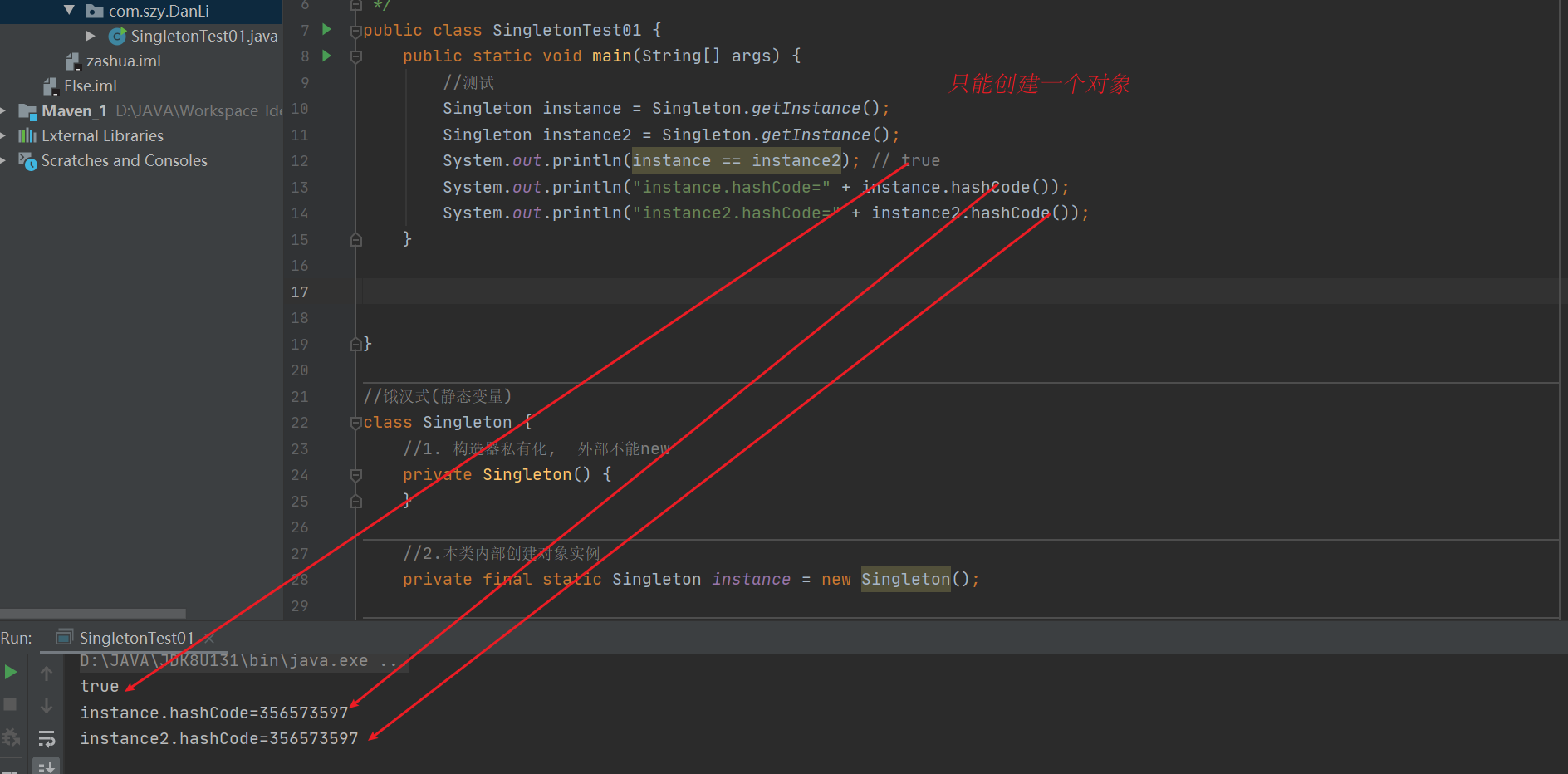
优缺点说明:
-
优点:这种写法比较简单,就是在类装载的时候就完成实例化。避免了线程同步问题。
-
缺点:在类装载的时候就完成实例化,没有达到 Lazy Loading 的效果。如果从始至终从未使用过这个实例,则会造成内存的浪费
-
这种方式基于 classloder 机制避免了多线程的同步问题,不过,instance 在类装载时就实例化,在单例模式中大多数都是调用 getInstance 方法, 但是导致类装载的原因有很多种,因此不能确定有其他的方式(或者其他的静态方法)导致类装载,这时候初始化 instance 就没有达到 lazy loading 的效果
-
结论:这种单例模式可用,可能造成内存浪费
饿汉式(静态代码块)
public class SingletonTest02 {
public static void main(String[] args) {
//测试
Singleton instance = Singleton.getInstance();
Singleton instance2 = Singleton.getInstance();
System.out.println(instance == instance2); // true
System.out.println("instance.hashCode=" + instance.hashCode());
System.out.println("instance2.hashCode=" + instance2.hashCode());
}
}
//饿汉式(静态变量)
class Singleton1 {
//1. 构造器私有化, 外部能 new
private Singleton1() {
}
//2.本类内部创建对象实例
private static Singleton1 instance;
static { // 在静态代码块中,创建单例对象
instance = new Singleton1();
}
//3. 提供一个公有的静态方法,返回实例对象
public static Singleton1 getInstance() {
return instance;
}
}
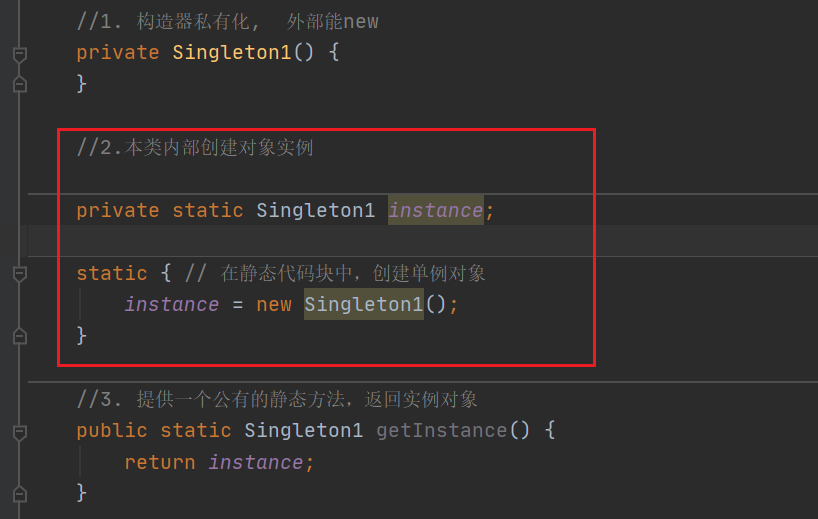
优缺点说明:
- 这种方式和上面的方式其实类似,只不过将类实例化的过程放在了静态代码块中,也是在类装载的时候,就执行静态代码块中的代码,初始化类的实例。优缺点和上面是一样的。
- 结论:这种单例模式可用,但是可能造成内存浪费
懒汉式(线程不安全)
package com.szy.DanLi;
/**
* @author BigMonster
* @create 2021-07-03 17:20
*/
public class SingletonTest03 {
public static void main(String[] args) {
System.out.println("懒汉式 1 , 线程不安全~");
Singleton instance = Singleton.getInstance();
Singleton instance2 = Singleton.getInstance();
System.out.println(instance == instance2); // true
System.out.println("instance.hashCode=" + instance.hashCode());
System.out.println("instance2.hashCode=" + instance2.hashCode());
}
}
class Singleton2 {
private static Singleton2 instance;
private Singleton2() {
}
//提供一个静态的公有方法,当使用到该方法时,才去创建 instance
//即懒汉式
public static Singleton2 getInstance() {
if (instance == null) {
instance = new Singleton2();
}
return instance;
}
}
优缺点说明:
- 起到了 Lazy Loading 的效果,但是只能在单线程下使用。
- 如果在多线程下,一个线程进入了 if (singleton == null)判断语句块,还未来得及往下执行,另一个线程也通过了这个判断语句,这时便会产生多个实例。所以在多线程环境下不可使用这种方式
- 结论:在实际开发中,不要使用这种方式.
懒汉式(线程安全,同步方法)
package com.szy.DanLi;
/**
* @author BigMonster
* @create 2021-07-03 17:37
*/
public class SingletonTest04 {
public static void main(String[] args) {
System.out.println("懒汉式 2 , 线程安全~");
Singleton instance = Singleton.getInstance();
Singleton instance2 = Singleton.getInstance();
System.out.println(instance == instance2); // true
System.out.println("instance.hashCode=" + instance.hashCode());
System.out.println("instance2.hashCode=" + instance2.hashCode());
}
}
// 懒汉式(线程安全,同步方法)
class Singleton4 {
private Singleton4() {}
private static Singleton4 instance;
//提供一个静态的公有方法,加入同步处理的代码,解决线程安全问题
//即懒汉式
public static synchronized Singleton4 getInstance() {
if(instance == null) {
instance = new Singleton4();
}
return instance;
}
}
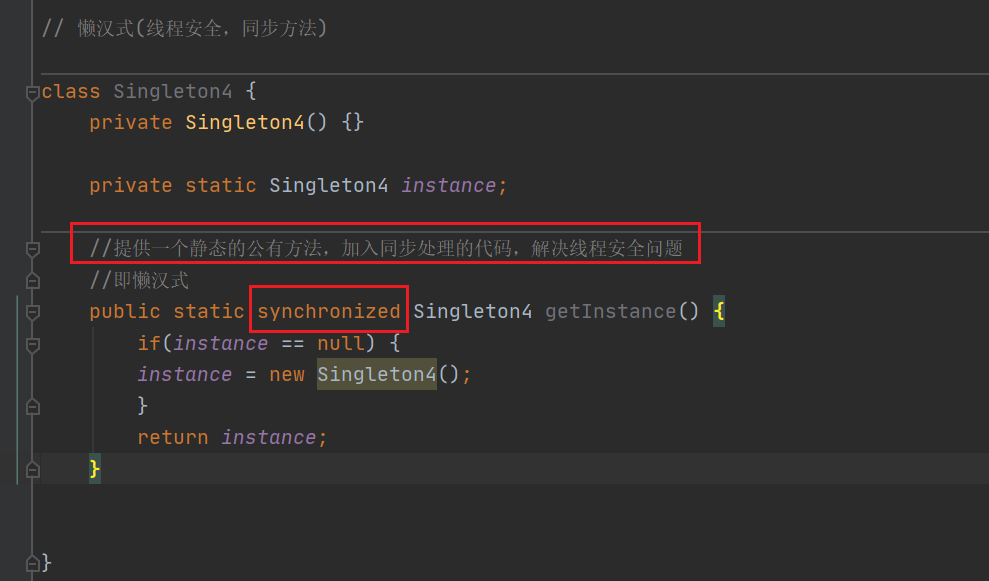
优缺点说明:
- 解决了线程安全问题
- 效率太低了,每个线程在想获得类的实例时候,执行 getInstance()方法都要进行同步。而其实这个方法只执行一次实例化代码就够了,后面的想获得该类实例,直接 return 就行了。方法进行同步效率太低
- 结论:在实际开发中,不推荐使用这种方式
懒汉式(同步机制放入代码块,无法实现线程安全)
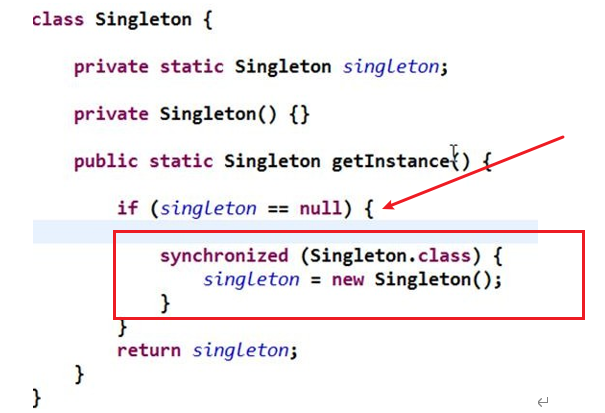
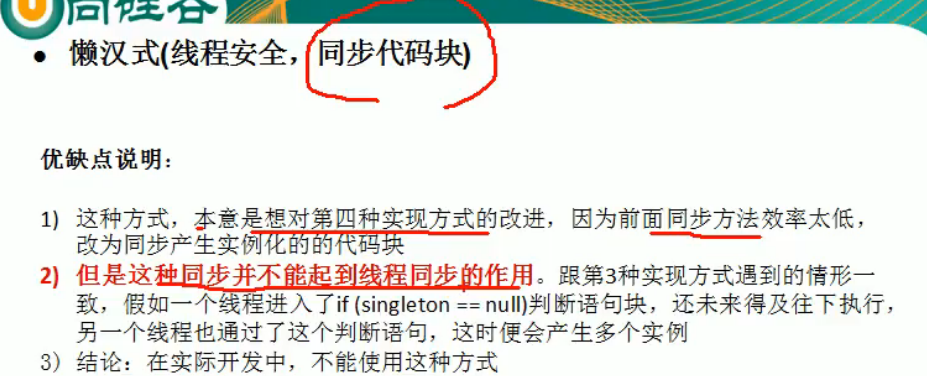
不推荐使用
双重检查推荐使用
代码实现
package com.szy.DanLi;
/**
* @author BigMonster
* @create 2021-07-03 20:51
*/
public class SingletonTest06 {
public static void main(String[] args) {
System.out.println("双重检查");
Singleton instance = Singleton.getInstance();
Singleton instance2 = Singleton.getInstance();
System.out.println(instance == instance2); // true
System.out.println("instance.hashCode=" + instance.hashCode());
System.out.println("instance2.hashCode=" + instance2.hashCode());
}
}
// 懒汉式(线程安全,同步方法)
class Singleton6 {
private static volatile Singleton6 instance;
private Singleton6() {
}
//提供一个静态的公有方法,加入双重检查代码,解决线程安全问题, 同时解决懒加载问题
//同时保证了效率, 推荐使用
public static synchronized Singleton6 getInstance() {
if (instance == null) {
synchronized (Singleton6.class) {
if (instance == null) {
instance = new Singleton6();
}
}
}
return instance;
}
}
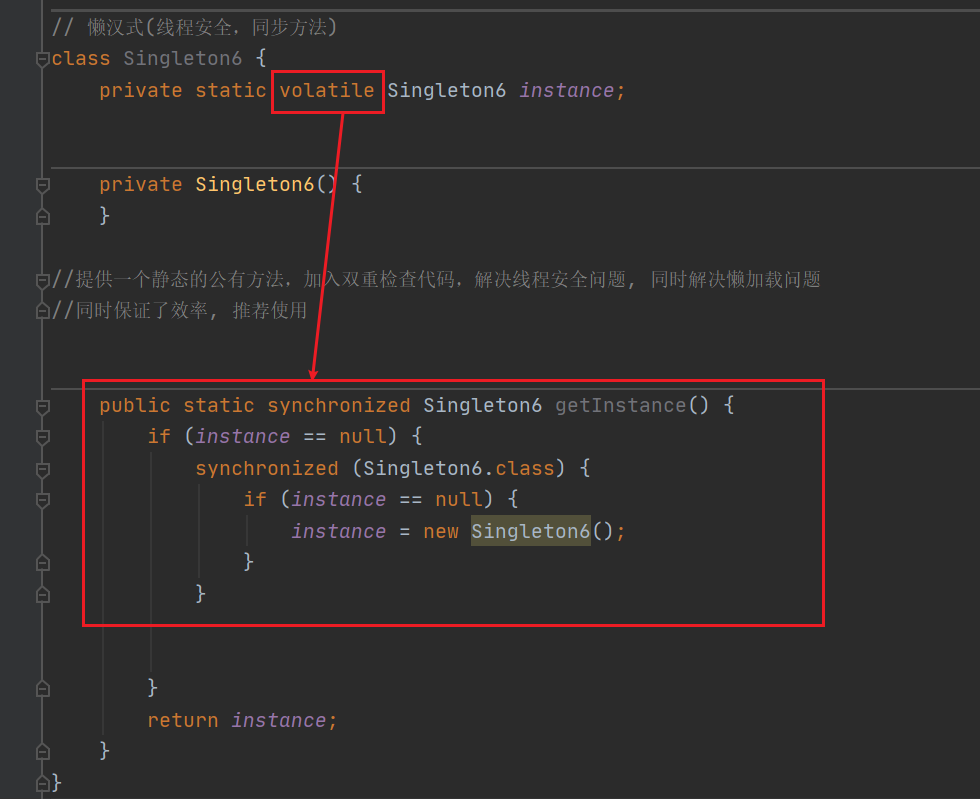
优缺点说明:
- Double-Check 概念是多线程开发中常使用到的,如代码中所示,我们进行了两次 if (singleton == null)检查,这样就可以保证线程安全了。
- 这样,实例化代码只用执行一次,后面再次访问时,判断 if (singleton == null),直接 return 实例化对象,也避免的反复进行方法同步.
- 线程安全;延迟加载;效率较高
- 结论:在实际开发中,推荐使用这种单例设计模式
静态内部类
package com.szy.DanLi;
/**
* @author BigMonster
* @create 2021-07-04 20:41
*/
public class SingletonTest07 {
public static void main(String[] args) {
System.out.println("使用静态内部类完成单例模式");
Singleton instance = Singleton.getInstance();
Singleton instance2 = Singleton.getInstance();
System.out.println(instance == instance2); // true
System.out.println("instance.hashCode=" + instance.hashCode());
System.out.println("instance2.hashCode=" + instance2.hashCode());
}
}
// 静态内部类完成, 推荐使用
class Singleton7 {
private static volatile Singleton7 instance;
//构造器私有化
private Singleton7() {
}
//写一个静态内部类,该类中有一个静态属性 Singleton7
private static class SingletonInstance {
private static final Singleton7 INSTANCE = new Singleton7();
}
//提供一个静态的公有方法,直接返回 Singleton7Instance.INSTANCE
public static synchronized Singleton7 getInstance() {
return SingletonInstance.INSTANCE;
}
}
静态内部类的特点:
-
这种方式采用了类装载的机制来保证初始化实例时只有一个线程。
-
静态内部类方式在 Singleton 类被装载时并不会立即实例化,而是在需要实例化时,调用 getInstance 方法,才会装载 SingletonInstance 类,从而完成 Singleton 的实例化。
-
类的静态属性只会在第一次加载类的时候初始化,所以在这里,JVM 帮助我们保证了线程的安全性,在类进行初始化时,别的线程是无法进入的。
-
优点:避免了线程不安全,利用静态内部类特点实现延迟加载,效率高
-
结论:推荐使用.
枚举 重点推荐
代码实现
package com.szy.DanLi;
/**
* @author BigMonster
* @create 2021-07-04 20:49
*/
public class SingletonTest08 {
public static void main(String[] args) {
Singleton8 instance = Singleton8.INSTANCE;
Singleton8 instance2 = Singleton8.INSTANCE;
System.out.println(instance == instance2);
System.out.println(instance.hashCode());
System.out.println(instance2.hashCode());
instance.sayOK();
}
}
//使用枚举,可以实现单例, 推荐
enum Singleton8 {
INSTANCE; //属性
public void sayOK() {
System.out.println("ok~");
}
}
优缺点说明:
- 这借助 JDK1.5 中添加的枚举来实现单例模式。不仅能避免多线程同步问题,而且还能防止反序列化重新创建新的对象。
- 这种方式是 Effective Java 作者 Josh Bloch 提倡的方式
- 结论:推荐使用
懒汉式与饿汉式总结
有没有一开始就在类加载的时候直接创建单一实例,或者说与没有进行判断
单例模式注意事项和细节说明
-
单例模式保证了 系统内存中该类只存在一个对象,节省了系统资源,对于一些需要频繁创建销毁的对象,使用单例模式可以提高系统性能
-
当想实例化一个单例类的时候,必须要记住使用相应的获取对象的方法,而不是使用 new
-
单例模式使用的场景:需要频繁的进行创建和销毁的对象、创建对象时耗时过多或耗费资源过多(即:重量级对象),但又经常用到的对象、工具类对象、频繁访问数据库或文件的对象(比如数据源、session 工厂等)


 浙公网安备 33010602011771号
浙公网安备 33010602011771号